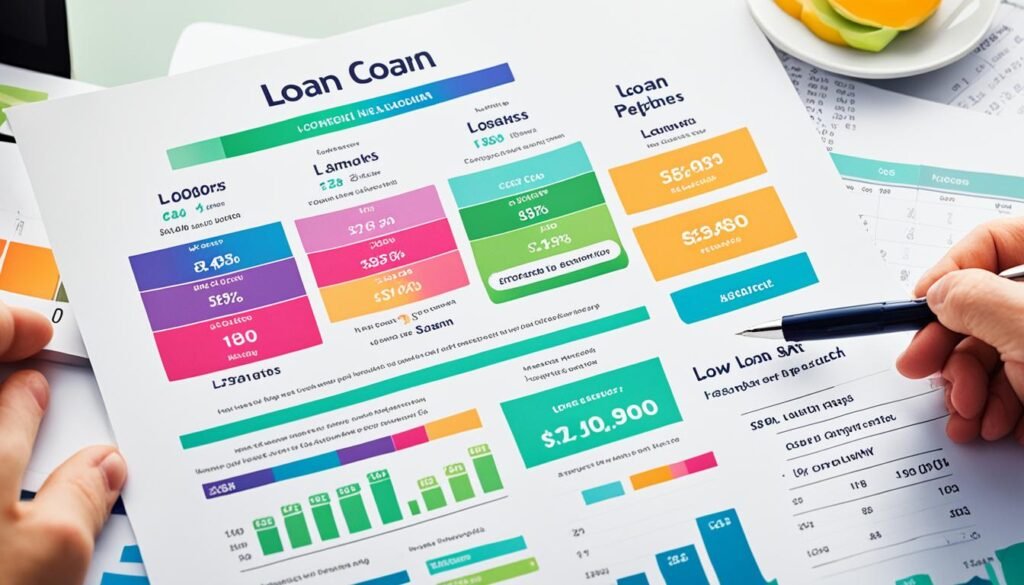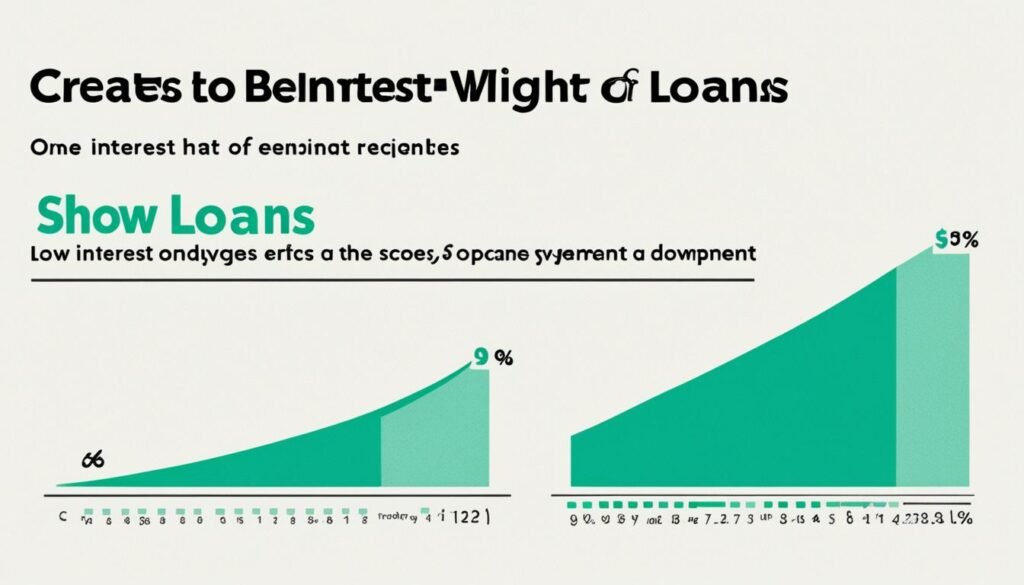Low Interest Personal Loans Looking for affordable options when it comes to personal loans? We’ve got you covered. In this article, we’ll explore the best low-interest personal loans available in the market. Whether you need funds for home improvement, debt consolidation, or any other financial needs, finding a loan with favorable terms is essential to save money and reach your goals.
When searching for the best low-interest personal loans, it’s important to consider factors such as interest rates, loan amounts, and repayment terms. By comparing various lenders and understanding the fine print, you can make an informed decision and select a loan that suits your needs.
To help you in your search, we’ve analyzed different lenders and their offerings. Let’s dive into the details of the best low-interest personal loans available:
Key Takeaways: Low Interest Personal Loans
- SoFi offers fixed rates starting from 8.99% APR for personal loans, making it an affordable option for borrowers.
- Factors such as credit score, debt-to-income ratio, and employment status can affect your personal loan rate.
- When comparing low-interest personal loans, consider factors like autopay discounts, prequalification, and additional fees.
- Credit unions and online lenders are great sources for low-interest personal loans.
- To qualify for a low-interest personal loan, focus on improving your credit score and maintaining a stable income.
- Low-interest personal loans offer advantages like affordability, quick funding, and credit-building opportunities.
- If low-interest personal loans aren’t suitable for your needs, consider alternative options like credit cards or home equity loans.
Now, let’s delve deeper into each section to understand how to find the best low-interest personal loans and the factors that can impact your borrowing experience.
Factors That Affect Your Personal Loan Rate
When applying for a personal loan, understanding the factors that can affect your loan rate is crucial. Your personal loan rate is determined by a combination of various elements, including your credit score, debt-to-income ratio, employment status, income, loan amount, loan term, and benchmark rates like SOFR (Secured Overnight Financing Rate).
Below, we’ll delve into each of these factors and explore how they can impact the interest rate you receive:
Credit Score
Your credit score plays a significant role in determining your personal loan rate. Lenders generally offer better interest rates to borrowers with higher credit scores. A good credit score, typically defined as 670 or higher, shows that you have a history of responsible borrowing and are less likely to default on the loan.
Debt-to-Income Ratio
Your debt-to-income (DTI) ratio is another crucial factor that lenders consider. It is calculated by dividing your total monthly debt payments by your monthly income. Lenders prefer borrowers with a lower DTI ratio, as it indicates a lower risk of default. Maintaining a low DTI ratio by keeping your debt levels in check can help you secure a more favorable interest rate.
Employment and Income
Lenders also consider your employment status and income level when determining your loan rate. Traditional employment, such as full-time or stable part-time employment, is viewed favorably by lenders. Additionally, lenders prefer borrowers with a higher income, as it demonstrates the ability to repay the loan promptly.
Loan Amount and Loan Term
The loan amount and term are factors that directly impact your personal loan rate. In general, larger loan amounts and longer loan terms often come with higher interest rates. This is because lenders consider larger loans and longer terms to be higher risk, as there is a greater chance of financial instability or changing circumstances over a more extended period.
Benchmark Rates
Benchmark rates, such as SOFR, are also influential in determining personal loan rates. These rates serve as reference points for lenders to establish the interest rates they offer to borrowers. Lenders typically add a margin to the benchmark rate to determine the final interest rate for personal loans.
Understanding these factors can help you make informed decisions when applying for a personal loan. By paying attention to your credit score, DTI ratio, employment, income, loan amount, loan term, and benchmark rates, you can work towards improving your eligibility for a lower interest rate.
Tips for Comparing Low-Interest Personal Loans

When comparing low-interest personal loans, there are several key factors to consider that can affect your overall borrowing experience. By analyzing these factors, you can make an informed decision and choose the loan option that best suits your needs.
1. Autopay Discounts
One important factor to consider when comparing low-interest personal loans is the availability of autopay discounts. Autopay discounts can provide an additional reduction in your interest rate. By enrolling in automatic loan payments, you not only ensure timely payments but also save money by lowering your interest charges.
2. Prequalification
Another useful tool for comparing personal loans is prequalification. Prequalification allows you to see which loan rates you qualify for without impacting your credit score. This step helps you gather multiple loan offers and choose the most favorable terms and rates.
3. Additional Fees
Be sure to carefully review the terms and conditions of each loan offer, paying close attention to any additional fees that may apply. Some lenders charge origination fees or prepayment penalties, which can add to the overall cost of your loan. Factor these fees into your comparison to get an accurate picture of the total cost.
4. Customer Support
Excellent customer support is crucial when choosing a personal loan. Look for lenders that offer accessible and helpful customer support options. This can include phone, email, or online chat support. Should any questions or concerns arise during the application or repayment process, reliable customer support can make a significant difference in your borrowing experience.
To help you visualize the differences between various personal loan offers, here’s a comparison table:
| Lender | Interest Rate | Autopay Discount | Origination Fee | Customer Support |
|---|---|---|---|---|
| Bank A | 7.99% | 0.25% | $0 | 24/7 phone and email support |
| Online Lender B | 8.99% | 0.50% | $100 | Live chat support during business hours |
| Credit Union C | 6.99% | 0.10% | $50 | Phone and email support during weekdays |
Reviewing these factors and using tools like prequalification can help you make an informed decision when comparing low-interest personal loans. Take your time to analyze the details and choose a loan option that aligns with your financial goals and priorities.
Where To Get Low-Interest Personal Loans

When looking for low-interest personal loans, it’s important to explore different lenders to find the best options for your needs. Consider the following sources:
Credit Unions
Credit unions are not-for-profit financial institutions that often offer competitive rates on personal loans. As member-owned organizations, they prioritize the financial well-being of their members and can provide lower interest rates compared to traditional banks.
Online Lenders
Online lenders have become increasingly popular due to their convenience and competitive rates. These lenders operate solely online, which allows them to keep overhead costs low and offer favorable loan terms to borrowers. Comparing different online lenders can help you find low-interest personal loan options.
Pre-Approval
Applying for pre-approval from different lenders can be a smart strategy to compare interest rates without impacting your credit score. This process involves submitting basic information and receiving potential loan offers from lenders. By reviewing pre-approved offers, you can make informed decisions and choose the lender that offers the lowest interest rates.
When considering low-interest personal loans, it’s essential to assess the lender’s terms, reputation, and customer reviews. Read the fine print, including any additional fees or requirements, to ensure you fully understand the loan terms before making a decision. By researching different lenders and comparing their offerings, you can find the best low-interest personal loan that suits your financial needs.
How To Qualify for a Low-Interest Personal Loan

Qualifying for a low-interest personal loan involves meeting specific criteria set by lenders. To increase your chances of approval and secure a lower interest rate, you should focus on the following factors:
1. Credit Score
Your credit score plays a significant role in determining your eligibility for a low-interest personal loan. Lenders prefer borrowers with a good credit score, typically 800 or higher. Maintaining a strong credit history, making timely payments, and keeping your credit utilization low can help improve your credit score.
2. Debt-to-Income Ratio
Lenders assess your debt-to-income ratio, which is the percentage of your monthly income that goes towards paying off debts. A lower debt-to-income ratio demonstrates better financial stability and increases your chances of qualifying for a low-interest personal loan. To improve your debt-to-income ratio, consider paying off high-interest debt or reducing your overall debt obligations.
3. Income Level
Your income level influences the amount you can borrow and affects the interest rate offered by lenders. Higher income generally signifies better repayment capacity, making you a more attractive borrower. Additionally, having a stable employment history and a reliable source of income further strengthens your loan application.
4. Collateral (for Secured Loans)
If you’re considering a secured personal loan, having collateral can increase your chances of qualifying for a low-interest rate. Collateral provides lenders with added assurance and reduces their risk, allowing them to offer more favorable loan terms. Examples of collateral include real estate, vehicles, or other valuable assets.
Building Your Credit, Increasing Your Income, and Reducing Debt
To position yourself for a low-interest personal loan, it’s essential to proactively work on improving your credit score, increasing your income, and reducing your debt. By paying bills on time, minimizing outstanding debts, and maintaining a strong credit profile, you can enhance your overall financial health and increase your chances of qualifying for the best loan options available.
Remember, each lender has their own set of qualifying criteria, and it’s crucial to research and compare multiple lenders to find the best terms and rates that suit your needs. Take the time to read the fine print, calculate the monthly payment affordability, and evaluate your financial situation before making a final decision.
By diligently considering the factors mentioned above and preparing your financial profile, you can position yourself for a low-interest personal loan that meets your needs and helps you achieve your goals.
Advantages and Disadvantages of Low-Interest Personal Loans

Low-interest personal loans offer several advantages that make them an attractive option for borrowers. Firstly, they provide access to affordable debt, allowing individuals to borrow money at lower interest rates. This can help them save money over the repayment period compared to loans with higher interest rates.
Additionally, low-interest personal loans come with fewer interest charges, reducing the overall cost of borrowing. This means that borrowers can repay their debt more efficiently and save on interest expenses.
Another advantage of low-interest personal loans is the quick funding they provide. When faced with unexpected expenses or financial emergencies, borrowers can rely on these loans to receive funds promptly.
Furthermore, low-interest personal loans offer an opportunity to build credit. Timely repayment of these loans can help borrowers improve their credit score, making it easier for them to secure better loan terms and rates in the future.
However, it’s important to consider the disadvantages of low-interest personal loans as well. One drawback is that they may reduce flexibility in your monthly budget. Loan repayments can take up a significant portion of your income, limiting your ability to allocate funds to other financial goals or expenses.
Another potential disadvantage is the risk of legal action in case of default. If you’re unable to repay the loan, the lender may take legal action to recover the borrowed amount, leading to potential financial and legal consequences.
During the application process, there might be a temporary dip in credit score due to the hard credit inquiry performed by the lender. However, this is typically short-lived and can be outweighed by the long-term benefits of responsible borrowing.
Lastly, taking on a low-interest personal loan may divert funds from other financial goals or investment opportunities. Borrowers should carefully evaluate their financial situation and consider the impact of loan repayments on their overall financial plan.
Considering the advantages and disadvantages of low-interest personal loans is crucial for making an informed decision. While these loans offer affordable debt, quick funding, and credit-building opportunities, borrowers should weigh their benefits against potential limitations such as reduced budget flexibility and the diversion of funds from other financial goals.
The Importance of Low-Interest Personal Loans

Low-interest personal loans play a crucial role in achieving financial goals and saving money. By securing a loan with a lower interest rate, borrowers can significantly reduce the overall cost of the loan and enjoy several financial benefits.
Cost-Saving:
One of the primary advantages of low-interest personal loans is the cost-saving potential. With a lower interest rate, borrowers can save a substantial amount of money over the life of the loan. This means paying less in interest charges and having more funds available for other essential expenses or savings.
For example, let’s consider a $20,000 personal loan with a 5-year term. If the interest rate is 10%, the total interest paid over the loan’s duration would be $7,667. However, if the interest rate is reduced to 6%, the total interest paid would decrease to $4,596, resulting in a significant cost-saving of $3,071.
Interest Reduction:
Low-interest personal loans allow borrowers to reduce the burden of high-interest charges. A lower interest rate translates into lower monthly payments, making it easier to manage monthly budgets and maintain financial stability. By reducing the interest portion of each payment, borrowers can allocate more funds toward paying off the principal amount, leading to faster debt repayment.
Achieving Financial Goals:
Financial goals, such as saving for a down payment on a home, starting a business, or pursuing higher education, often require a significant amount of money. By securing a low-interest personal loan, borrowers can access the necessary funds while minimizing the financial strain. With a lower interest rate, borrowers can achieve their financial goals more efficiently and effectively.
Whether it’s saving for a dream vacation or consolidating higher-interest debt, low-interest personal loans provide an avenue to reach these goals without sacrificing financial stability.
Borrow Responsibly:
While low-interest personal loans offer several advantages, it’s crucial to approach borrowing responsibly. Before taking on any loan, evaluate your financial situation, create a budget, and assess your ability to make timely repayments. Consider your monthly income, expenses, and other existing financial obligations to ensure that taking on additional debt aligns with your overall financial goals.
Remember to compare loan offers, terms, and conditions from different lenders to find the best low-interest personal loan that suits your needs. Additionally, be mindful of any additional fees, such as origination fees or prepayment penalties that may impact the overall cost of the loan.
In conclusion, low-interest personal loans have a vital role in financial planning and achieving long-term goals. By reducing the cost of borrowing and offering greater affordability, borrowers can navigate their financial journeys with confidence and save money along the way.
How To Get a Low-Interest Personal Loan

When it comes to getting a low-interest personal loan, understanding the application process and implementing certain strategies can help you secure the best rates. Here are some key steps to follow:
1. Prequalification: Assess your eligibility and rates
Begin by considering prequalification offered by lenders. This process allows you to determine your eligibility and also provides you with potential interest rates based on your financial profile. By prequalifying, you can avoid multiple hard credit inquiries that could negatively impact your credit score.
2. Improve your credit score (if needed)
Your credit score plays a crucial role in securing a low-interest personal loan. If your credit score is not in the optimal range, taking steps to improve it can be beneficial. Paying off outstanding debts, reducing your credit utilization, and ensuring timely payments can help boost your score over time.
3. Consider adding a cosigner
If you have a less-than-ideal credit score or limited credit history, having a cosigner with a strong credit profile can enhance your chances of approval and help you secure a lower interest rate. A cosigner acts as a guarantor for the loan, assuming responsibility for repayment if you default.
4. Opt for a shorter repayment term
Choosing a shorter repayment term can significantly impact the interest rate you qualify for. Lenders often offer lower rates for shorter terms as they involve less risk. Assess your financial situation and choose a term that aligns with your ability to make timely payments while securing a favorable interest rate.
5. Explore rate discounts
Lenders may offer various rate discounts that can further reduce your interest rate. These discounts can include enrolling in autopay or making direct payments from your bank account. Take advantage of these options to maximize your savings and secure a low-interest personal loan.
“To secure a low-interest personal loan, it’s essential to follow the application process diligently, consider prequalification, improve your credit score, explore cosigner options, choose a shorter repayment term, and take advantage of any rate discounts offered by the lender.”
If you follow these steps and carefully consider each factor, you can improve your chances of getting a low-interest personal loan that aligns with your financial goals.
Alternatives to Low-Interest Personal Loans

If low-interest personal loans do not align with your specific borrowing needs, there are several alternative options to consider:
- Credit Cards: Credit cards can provide a flexible line of credit that allows you to make purchases and repay the balance over time. Keep in mind that credit cards often come with higher interest rates compared to personal loans, so it’s important to manage your credit card debt responsibly.
- Home Equity Loans: If you own a home and have built up equity, a home equity loan may be an option. This type of loan allows you to borrow against the value of your home and typically offers competitive interest rates. However, it’s important to consider that your home acts as collateral for the loan, so failure to repay could result in the loss of your home.
- Lines of Credit: Similar to credit cards, lines of credit provide you with access to a predetermined amount of funds that you can borrow and repay as needed. This type of loan offers flexibility and may have lower interest rates compared to credit cards. Lines of credit can be secured or unsecured, depending on the lender and your financial situation.
- Alternative Lenders: Alternative lenders, such as online lending platforms, offer additional options for borrowing money. These lenders may have different eligibility requirements and terms compared to traditional banks. It’s important to carefully research and compare alternative lenders before choosing a loan option.
Consider these alternatives and evaluate their terms, interest rates, and repayment options to determine which option best suits your financial needs. Remember to borrow responsibly and only take on debt that you can comfortably repay.
Personal Loan Rates and Details: Forbes Methodology

When it comes to providing accurate and reliable information about personal loan rates and details, Forbes Advisor follows a rigorous methodology. They strive to offer readers a comprehensive evaluation of personal loan companies, ensuring that borrowers can make informed decisions based on trustworthy data.
Forbes Advisor’s methodology involves gathering extensive data points and analyzing multiple factors to assess different lenders. These factors include loan costs, eligibility criteria, customer experience, and company reputation.
One of the key components of Forbes Advisor’s methodology is the emphasis on fact-checking. By verifying the information presented, Forbes ensures that readers can rely on the accuracy of their data. This commitment to fact-checking is crucial in an industry where loan details and rates can vary.
“Forbes Advisor’s methodology includes extensive research and fact-checking to ensure accurate information is presented to readers.”
By following this methodology, Forbes Advisor ensures that their personal loan rates and details are reliable and up-to-date. This allows borrowers to compare lenders based on trustworthy information, making it easier to find the loan that best suits their needs.
Forbes Advisor’s Personal Loan Ratings
Forbes Advisor’s ratings provide borrowers with a clear overview of different lenders in the personal loan market. These ratings showcase the strengths and weaknesses of each lender, allowing borrowers to make better-informed decisions.
| Lender | Loan Costs | Eligibility | Customer Experience | Company Reputation |
|---|---|---|---|---|
| BestLend | 4.5/5 | 4/5 | 4.5/5 | 4/5 |
| FastLoan | 3.5/5 | 3/5 | 4/5 | 3/5 |
| QuickCash | 4/5 | 4.5/5 | 3.5/5 | 3.5/5 |
Forbes Advisor’s ratings are designed to provide a comprehensive assessment of each lender’s loan costs, eligibility criteria, customer experience, and company reputation. The ratings can help borrowers make more informed decisions by highlighting the strengths and weaknesses of different lenders.
By following their robust methodology, Forbes Advisor aims to empower borrowers with reliable and accurate information about personal loan rates and details. This ensures that borrowers can evaluate lenders based on trustworthy data, ultimately helping them find the loan that aligns with their financial goals.
How we chose our picks for the best personal loan lenders
To select the top personal loan lenders, we conducted thorough research encompassing several key factors. Firstly, we evaluated interest rates, considering both fixed and variable options. Next, we scrutinized loan terms, including repayment periods and flexibility. Additionally, we examined lender reputation, customer service quality, and accessibility. We analyzed fees, such as origination and prepayment penalties, to ensure transparency. Moreover, we considered eligibility criteria and application processes, aiming for simplicity and efficiency. Lastly, we assessed customer reviews and feedback to gauge overall satisfaction and reliability. By weighing these criteria, we identified the best personal loan lenders to recommend.
Interest rates by credit score
Interest rates vary based on credit scores, with lower rates typically offered to those with higher scores. For individuals with excellent credit scores (generally above 720), interest rates tend to be lower, often ranging from around 5% to 10%. Those with good credit scores (typically between 660 and 719) might encounter rates between 10% and 15%. Meanwhile, individuals with fair to poor credit scores (below 660) may face higher rates, ranging from 15% to 36% or more. Lenders determine rates based on creditworthiness, so maintaining a good credit score can lead to more favorable interest rates on loans.
SoFi Personal Loan
SoFi Personal Loan offers competitive interest rates and flexible terms for borrowers seeking financing for various purposes. With loan amounts ranging from $5,000 to $100,000, borrowers can consolidate debt, finance home improvements, or cover major expenses. SoFi’s online application process is streamlined, and borrowers may receive funds within days of approval. Additionally, SoFi provides unemployment protection, allowing eligible borrowers to pause loan payments temporarily in case of job loss. With no origination fees or prepayment penalties, SoFi Personal Loan stands out as an attractive option for those seeking affordable and convenient borrowing solutions.
How to Get the Best Personal Loan Rates In 2024
Securing the best personal loan rates in 2024 requires careful planning and preparation. Start by improving your credit score through timely bill payments and reducing outstanding debt. Research and compare rates from multiple lenders, including banks, credit unions, and online lenders. Consider opting for a secured loan if you have collateral to offer, as it often leads to lower interest rates. Additionally, try to borrow only what you need and opt for shorter loan terms to minimize interest costs. Lastly, leverage any available discounts or incentives offered by lenders to further reduce your interest rate and overall borrowing expenses.
Best For: Flexibility and debt consolidation
Ideal for those seeking flexibility and consolidating debt, this option offers customizable terms and favorable conditions. Whether you’re juggling multiple debts or need a loan tailored to your financial situation, this choice provides the versatility you require. With adaptable repayment schedules and potential for lower interest rates, it empowers borrowers to manage their finances efficiently. By consolidating debts into a single manageable payment, it simplifies financial obligations and helps individuals regain control over their finances. Whether you’re aiming to pay off credit cards or streamline various loans, this option stands out for its flexibility and effectiveness in debt consolidation.
BEST FOR LOW RATES AT A CREDIT UNION
For individuals prioritizing low rates, credit unions stand out as the top choice. With a focus on serving members rather than maximizing profits, credit unions often offer more competitive interest rates on personal loans compared to traditional banks. Membership eligibility criteria vary, but many credit unions welcome diverse groups, including specific professions or local communities. By joining a credit union, borrowers can access favorable rates, personalized service, and community-focused banking. Whether you’re financing a major purchase or consolidating debt, credit unions excel in providing affordable lending solutions, making them the best option for securing low rates on personal loans.
Personal Loan Calculator
A personal loan calculator is a valuable tool for borrowers to estimate loan payments and plan their finances. By inputting variables such as loan amount, interest rate, and loan term, users can quickly determine monthly payments and total interest costs. Some calculators also allow users to adjust parameters to compare different loan options and find the most suitable terms for their budget. Additionally, these calculators can provide insights into the impact of making extra payments or adjusting the loan term. Overall, a personal loan calculator empowers borrowers to make informed decisions and understand the financial implications of borrowing.
Also Read: Get A World Finance Loan Quick And Reliable
Conclusion
Exploring low-interest personal loans is crucial for achieving financial goals and reducing interest expenses. By comparing lenders, considering important factors, and understanding the loan terms, borrowers can make informed decisions and secure the best options.
Responsible borrowing is key to maintaining financial stability. With low-interest personal loans, borrowers can make progress towards their financial objectives while managing their debt responsibly.
Whether it’s consolidating high-interest debt, funding a home renovation, or covering unexpected expenses, low-interest personal loans provide the means to achieve these goals without incurring excessive interest charges.
By responsibly managing their borrowing and making timely repayments, borrowers can develop a strong credit history and improve their overall financial well-being.
FAQs
Q: What are the best low interest personal loans available?
A: The best low interest personal loans typically come from reputable lenders offering competitive interest rates and favorable terms. You can explore options from online lenders like SoFi, Best Egg, and others.
Q: How can I get a personal loan with the lowest interest rate?
A: To secure a personal loan with the lowest interest rate, you should have a good credit score, stable income, and a low debt-to-income ratio. Shopping around and comparing offers from different lenders can also help you find the best rate.
Q: What is the average personal loan interest rate in April 2024?
A: The average personal loan interest rate can vary based on market conditions and your creditworthiness. It’s advisable to check with different lenders to see the rates they offer in April 2024.
Q: How do I manage a personal loan effectively?
A: Managing a personal loan involves making timely payments, tracking your loan balance, and staying within your budget. You can also consider refinancing your loan if you find better terms elsewhere.
Q: Where is the best place to get a personal loan that suits my needs?
A: The best place to get a personal loan depends on your specific requirements. Online lenders, credit unions, and traditional banks are common options. Compare rates, fees, and terms to find the best fit for you.
Q: What is the maximum loan amount I can borrow with a personal loan?
A: The maximum loan amount you can borrow with a personal loan varies by lender and is typically based on your creditworthiness, income, and other factors. It’s best to check with the lender directly for this information.
Q: How can I find the best personal loan rates for my situation?
A: Finding the best personal loan rates involves comparing offers from different lenders, considering your credit score, income, and loan amount. Look for lenders that offer competitive rates and terms that suit your financial goals.
Source Links
- https://www.marketwatch.com/guides/personal-loans/best-low-interest-personal-loans/
- https://www.forbes.com/advisor/personal-loans/best-low-interest-personal-loans/
- https://www.bankrate.com/loans/personal-loans/low-interest-rates/
